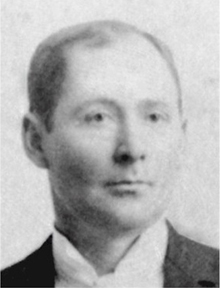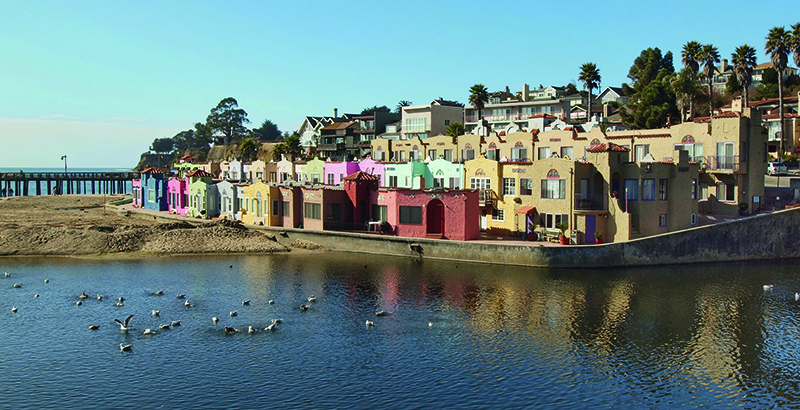
Wolfe in his early 30s.
Frank Delos Wolfe (1862-1926) was the most important architect practicing in San Jose, California in the beginning of the 1900s. Although his clientele spanned across a great portion of northern California, most of his work was done in San Jose where his designs make up significant parts of many of San Jose’s historic neighborhoods – Naglee Park, Hanchett Park, Vendome, Hensley District, and Palm Haven.
Wolfe was born in Fremont, Ohio, September 29, 1862. As a young man, he and his wife Nellie moved to Newton, Kansas, where he worked for architect W. L. Ross and his son Carl was born. In 1888, he moved to San Jose, California, where he set up shop as a contractor and builder, and by 1895, he had established himself as an architect and hired Charles McKenzie.
Wolfe & McKenzie Years
In 1899 Wolfe and Charles McKenzie became partners. Wolfe & McKenzie had a very fruitful partnership for the next 11 years. Four of their projects are today on the National Register of Historic Places: a residence and carriage house for Willard Griffin in the Los Altos Hills, the old Gilroy City Hall, the Peck-Wilson house in Palo Alto, and the Paul Shoup house in Los Altos.
Wolfe & McKenzie worked in a range of styles, from Japanese-influenced to Mission Revival to Colonial to Craftsman. In 1907, they published a book of their designs that shows their wide range of styles. In 2004, the late historical architect and Wolfe expert George Espinola reissued the Wolfe & McKenzie Book of Designs as Cottages, Flats, Buildings & Bungalows: 102 Designs from Wolfe & McKenzie 1907. Espinola added much information on the architects, the locations of the houses in the book, and the histories of the houses.
Espinola also identified the Wolfe & McKenzie style:
…hipped or hipped-gable roof forms with small centrally located dormers. Overhangs were typically deep and boxed in, although on their less formal designs rafter tails were often left exposed and sometimes curved. A favorite device…was the cantilevered corner window box that included tightly spaced carved brackets below. Windows were typically double hung or picture windows with simple leaded patterns at their tops. Second floor roof decks or balconies were common, sometimes functional and other times purely decorative.
The Naglee Park residential subdivision opened in 1902, and is a showcase for Wolfe & McKenzie architecture. The pair designed probably one-quarter of the houses in Naglee Park, either together or later as sole practitioners. They also did much work in the Hanchett Park subdivision, which opened in 1906. In 1910, despite their great success, they dissolved their partnership.
The Sole Practitioner Years
Frank Wolfe worked as a sole practitioner from January 1911 to late in 1917. In 1912, his son Carl became an associate in the firm. During the Wolfe & Wolfe years, Frank did some of his most interesting and important work. This period resulted in the firm's signature style, the California Prairies, inspired by the Midwestern Prairie school of architecture of which Frank Lloyd Wright was the most famous practictioner. The firm of Wolfe & Wolfe became known for unusual and exciting architecture.
Today, some of the most well-known of Wolfe's designs are the Prairie-style homes that make San Jose a western center for this type of architecture. A daring design for its time, the popularity of Prairie architecture has only grown, with many websites and books and organizations dedicated to it. A Wolfe Prairie home is probably more desirable today than it was in the early 20th century.
There are over 40 documented Wolfe Prairies still standing in Northern California, many with original interiors. A Wolfe Prairie is special, as any owner can tell you. The Prairies appeal to both those who like modern houses and those who love old houses. With their flat roofs, cubic form, classical ornamentation, tilework, and beautiful art glass windows, the Wolfe & Wolfe Prairies are timeless works of art.
During this period, Wolfe created what are some of his most notable designs, including three that are now on the National Register: the Charles Miller house in Saratoga, Woodhills, the Fremont Older country home in Cupertino, and the Milpitas Grammar School.
Wolfe worked on at least two hundred projects during his sole practitioner period; about half of them are still standing today, and at least forty of those buildings are or were known to be Prairies.
Read more about the work of Wolfe & Wolfe.
Wolfe & Higgins: Master Architects of the Spanish Revival
In November 1917, Frank Wolfe partnered with his son Carl Wolfe and Santa Clara architect William Ernest Higgins to form what would become one of the most prolific architectural firms of its time. Early adopters of the Spanish Revival style that swept California in the 1920s, the firm of Wolfe & Higgins lasted only fourteen years but in that short time produced nearly 500 homes, commercial buildings, and institutional buildings. Among these are some of the most recognizable architectural landmarks in Northern California and some of the most beautiful houses in San José.
The Wolfe & Higgins signature style was characterized by red tile roofs, triple arched doors and windows, and ornate door surrounds.The firm produced well-known buildings such as the Venetian Court Apartments in Capitola, one of the first condominium complexes in California, today on the National Register of Historic Places.

After Frank Wolfe died in 1926, his son Carl took over Frank’s partnership in the firm, which continued to produce for another five years. Carl continued the legacy of his father's business until his premature death in 1931. Among his notable works were the San Jose Woman's Club Spanish Revival building, today a San Jose City Landmark.
Read more about the work of Wolfe & Higgins.
